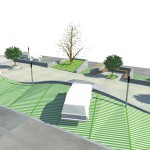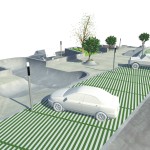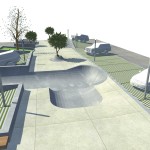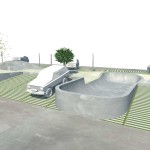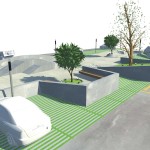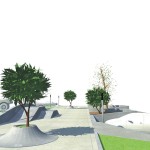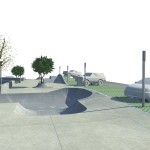Concursul international organizat de Nissan in 2009, in vederea colectarii unor idei istete pentru spatiile de parcare, avea in subtext dorinta de promovare a modelului Quashquai. Propunerile selectate au fost insa din cele mai putin practice si/sau inovatoare, fiind mai degraba complementare reclamelor naive din seria Quashquai.
De vreme ce inovarea parcarii este o directie moarta – cel putin pina nu se schimba si conceptul de automobil – si spunem asta pentru ca ultimele decenii nu au mai produs solutii noi in domeniu, solutia noastra a avut o abordare mai curand urbanistica, prin care am incercat sa lucram asupra calitatii spatiului. Ne-am propus atunci sa depasim perceptia stinjenitoare pe care o au parcajele in peisajul urban si sa gasim un raport convenabil intre utilitatea acestora si deranjul pe care tot ele il provoaca. Reproducem mai jos textul care a insotit si explicitat propunerea noastra in competitie. Imaginile alaturate reprezinta machetele celor trimise la concurs si care, desigur, aveau modelele Nissan suprapuse.
Wether it lies along the avenues, among the buildings, or it is underground, the parking is an embarrassing presence in the urban landscape. The spaces used for parking prove the city’s ambivalence towards them: on the one hand necessary and precious, on the other, unwanted and hidden.
Our proposal represents an urban parking concept which brings together the utility of the parking box and care for the image of the city. The parking is put together with the pedestrian street, leisure areas and playgrounds (including those for skaters and bikers), in a way in which, its presence contributes to the quality of the urban image. Besides a car is a design object which could be exhibited in a suitable urban setting. Such an attitude makes possible the existence of parkings in areas where today it would be considered unacceptable.
If we borrow the contemporary vocabulary of landscape development, the quality of the parking box could easily be upgraded. Interfering directly with the shape and design of the parking place, one can change it into an urban space: the artificial topography of the ground, boundaries of walls of different heights, green pavements, discontinuity of the parking rows by interposing areas with different functions. The costs for such measures are low comparing with the land’s value and the interest for free building space in the cities.

